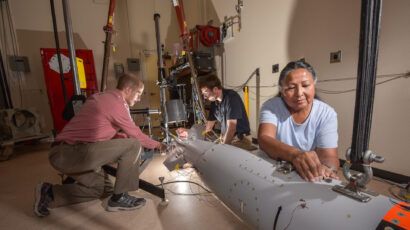Twenty-five years after Reagan’s Star Wars speech
By David Wright, Lisbeth Gronlund | April 1, 2008
On March 23, 1983, President Ronald Reagan made his famous Star Wars speech, announcing his plan to develop a missile defense system that would make nuclear weapons “impotent and obsolete.” His vision of a “shield that could protect us from nuclear missiles just as a roof protects a family from the rain” was both seductive and audacious.
It was seductive because it offered an easy answer to the omnipresent threat of a massive Soviet nuclear attack at a time when the Soviets and the United States maintained 60,000 nuclear warheads between them. It especially appealed to those who believed in the supremacy of U.S. science and technology but did not understand technical issues.
At the same time, Reagan’s speech was audacious because it flew in the face of all that the United States had come to understand about missile defenses over the previous 30 years. The Pentagon had been working on defenses against ballistic missiles since the 1950s–almost as long as it had been working on ballistic missiles. By 1972, both Washington and Moscow concluded that offense had significant inherent advantages over defense and that an effective defensive system wasn’t feasible. They also believed that building defenses could lead to an arms race by inducing each country to build more missiles to overwhelm the other’s defenses. Thus, under the Anti-Ballistic Missile (ABM) Treaty, both nations gave up the possibility of defending against each other’s nuclear-armed missiles.
Twenty-five years later, antimissile technology has come a long way. Guidance and homing have improved so much that all current U.S. missile defense systems use hit-to-kill technology intended to destroy the incoming target by ramming into it. Previous defenses against long-range missiles were designed to use nuclear-tipped interceptors to destroy a warhead at a distance.
In recent years, the United States has also built and fielded a significant amount of hardware as part of its ground-based missile defense system, including 24 silo-based interceptors in Alaska and California and a new sea-based X-band radar in the Pacific Ocean. It has also upgraded the Cobra Dane radar in Alaska and two early-warning radars–in California and Britain–and fielded a transportable X-band radar in Japan.
Meanwhile, the rationale has changed–and is less daunting. Defending against a few potential North Korean or Iranian long-range missiles is far less demanding than defending against thousands of incoming Soviet missiles.
Regardless, Reagan’s dream of building a viable defense against long-range missiles is still simply that–a dream. And by pursuing this dream, the United States has weakened its own security instead of enhancing it.
The real legacy of Reagan’s dream
Let’s take a clear-eyed look at what 25 years have brought us: First, the Pentagon has yet to demonstrate that the U.S. ground-based missile defense system is capable of defending against a long-range ballistic missile in a real-world situation. The tests have demonstrated that the kill vehicle is able to home in on and collide with an identifiable target, but under highly scripted conditions. A February 2008 Government Accountability Office report, “Assessment of DOD Efforts to Enhance Missile Defense Capabilities and Oversight” concluded that these tests have been “developmental in nature, and do not provide sufficient realism” to assess the system’s potential effectiveness.
To permit deployment of the fledgling ground-based missile defense system, the Pentagon exempted it from the normal accounting and testing procedures that apply to all other weapons systems. For example, the system does not comply with so-called “fly before you buy” laws, which are designed to prevent the military from purchasing weapons that are unsuitable for their real-world mission or don’t work as intended. Under these laws a major defense program may not produce more than a small number of weapons–generally for testing purposes–until the Pentagon’s director of operational testing and evaluation issues a report stating whether the testing and evaluation was adequate and whether the results show that the weapon system is effective and suitable for combat. That won’t be possible until the Pentagon conducts realistic tests, a prospect that may never occur.
To circumvent the rules, the Missile Defense Agency refers to the ground-based missile defense components as fielded rather than deployed and has claimed that they’re test assets used as part of the test program.
Second, there’s almost no prospect that the United States will develop a defense system that could defend against real-world long-range missiles in the foreseeable future. As a 2000 Union of Concerned Scientists/MIT technical report, “Countermeasures,” concluded, any country with the capability and motivation to build long-range missiles and fire them at the United States also would have the capability and motivation to equip those missiles with effective countermeasures such as decoys.
Third, as long as the United States and Russia continue to maintain nuclear weapons to deter each other, any U.S. steps to deploy a defense system that Russia believes could intercept a significant number of its survivable long-range missile forces will undermine efforts to reduce nuclear threats. This link between offensive weapons and missile defenses was clearly demonstrated in the 1986 Reykjavik summit meeting, when Reagan’s adherence to missile defense scuttled an opportunity to pursue Soviet President Mikhail Gorbachev’s offer to negotiate deep cuts in nuclear stockpiles. Ironically, missile defense precluded taking a real step toward achieving Reagan’s goal of rendering nuclear weapons obsolete.
U.S. missile defenses are an obstacle to real security
Today, the risk of a premeditated Russian or Chinese nuclear attack on the United States is essentially zero. But because Russia continues to maintain more than 1,000 nuclear weapons on high alert (as does the United States), ready to be launched within minutes, there’s still a danger of an accidental or unauthorized attack or of a mistaken launch in response to a false warning. Indeed, such attacks are the only military threats that could destroy the United States as a functioning society.
Russia’s incentive to maintain its weapons on alert would be strengthened if it believed that the United States was deploying a system that could threaten its ability to retaliate. In fact, when the United States tried to renegotiate the terms of the ABM Treaty in the late 1990s, it argued that Russia need not fear a U.S. defense system as long as it kept its missiles on high alert. Doing so would allow Russia, on warning of a U.S. first strike, to quickly launch a retaliatory attack large enough to overwhelm the defense.
Meanwhile, China has a small arsenal of roughly 20 long-range missiles that it relies on for deterrence. However, it could decide to offset U.S. defense deployments by increasing its arsenal, which could prompt India and then Pakistan to increase their nuclear arsenals.
On one level, the United States is aware of this linkage. It has stressed that its ground-based missile defense system is intended to protect against potential threats from developing countries and has stated that deployments would be “limited” so that Russia and China wouldn’t see them as a threat to their nuclear deterrents. But from Russia’s and China’s perspective, the issue is whether U.S. actions match its words.
In the coming years, the United States plans to increase the number of interceptors that are capable–at least in principle–of defending against long-range missiles. Congress has allocated funds for 40 ground-based missile defense interceptors to be deployed in Alaska and California. The United States is negotiating with Poland and the Czech Republic to deploy an additional 10 ground-based missile defense interceptors and one or two radars in Europe near the Russian border. Russia has strongly objected to this plan.
Within five years, the United States is also slated to deploy some 150 interceptor missiles on 18 ships as part of its Aegis Ballistic Missile Defense System. While these interceptors are designed to defend against intermediate-range ballistic missiles, the United States plans to produce an upgraded version of the interceptor to allow the Aegis system to defend against long-range missiles as well. This could cause Russia and China to worry that they could soon face some 200 U.S. interceptors designed to destroy long-range missiles.
Compared with China’s 20 long-range nuclear-armed missiles, 200 interceptors constitute a relatively large deployment. While Russia has a far larger arsenal, it may assume that most of it would be destroyed by a U.S. first strike. While the scientists in these countries may understand that these interceptors can be defeated by straightforward countermeasures, their political and military leaders, motivated by worst-case analyses and the desire for a response that is visible to its public and the United States, may build or retain larger nuclear forces than they would otherwise consider necessary, and in the Russian case may keep their missiles on high alert.
The real legacy of Reagan’s Star Wars speech is that missile defense has become a high-profile, politically symbolic program, rather than a military program judged on its merits. The continued political support for a program that still offers no prospect of defending the United States from a real-world missile attack and undermines efforts to eliminate the real nuclear threats to the United States shows that Reagan’s vision remains seductive–dangerously so.
Together, we make the world safer.
The Bulletin elevates expert voices above the noise. But as an independent nonprofit organization, our operations depend on the support of readers like you. Help us continue to deliver quality journalism that holds leaders accountable. Your support of our work at any level is important. In return, we promise our coverage will be understandable, influential, vigilant, solution-oriented, and fair-minded. Together we can make a difference.
Topics: Nuclear Weapons, Opinion
















